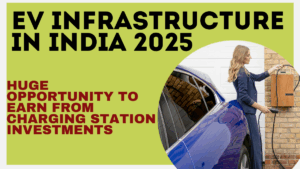The electric vehicle (EV) revolution in India is gaining momentum in 2025. With government policies supporting green energy and rising fuel costs pushing consumers toward EVs, the need for robust EV infrastructure is greater than ever. For entrepreneurs and investors, this presents a once-in-a-decade opportunity to earn profits by building and investing in charging stations across the country.

Why EV Infrastructure is Booming in 2025
Several factors are contributing to the rapid growth of EV adoption and the demand for charging stations:
-
Government Push: Schemes like FAME II and new state EV policies offer subsidies and tax benefits for charging infrastructure.
-
Consumer Demand: Sales of EVs, including two-wheelers, cars, and buses, are expected to cross 2 million units in 2025.
-
Corporate Adoption: Logistics companies, cab aggregators, and delivery services are shifting to EV fleets.
-
Urban Necessity: Metro cities like Delhi, Bengaluru, and Mumbai face high EV density, requiring accessible charging hubs.
This ecosystem creates a profitable market for anyone willing to invest in EV infrastructure businesses.
Types of EV Infrastructure Investments
Investors have multiple options to participate in India’s EV growth story:
-
Public Charging Stations
-
High-demand locations: highways, malls, tech parks.
-
Moderate to high investment with recurring revenue.
-
-
Private Fleet Charging Solutions
-
Tie-ups with logistics and cab companies.
-
Stable long-term contracts ensure consistent income.
-
-
Battery Swapping Stations
-
Growing popularity for two-wheelers and three-wheelers.
-
Faster turnaround than traditional charging.
-
-
Renewable-Powered Charging Hubs
-
Using solar/wind energy reduces operating costs.
-
Appeals to eco-conscious consumers and businesses.
-
Investment Required
The cost of setting up charging stations varies:
-
Basic AC Charger (slow): ₹5–7 lakh
-
Fast DC Charger: ₹20–40 lakh
-
Ultra-Fast Charging Hub: ₹50 lakh–₹1 crore
Additional expenses include land/rent, high-capacity power connections, and branding. However, government subsidies can reduce startup costs by 15–30% depending on state policies.
Earnings Potential
The revenue model depends on location, charging demand, and pricing strategy.
-
Tariff per kWh: ₹15–₹20
-
Daily Vehicles: 25–40 at mid-sized stations; 70+ at highway hubs
-
Monthly Earnings: ₹2.5–6 lakh for standard setups; higher for ultra-fast charging hubs
With EV sales expected to grow 50% annually in the next few years, earnings will only rise further.
Government Policies Supporting EV Infrastructure
To accelerate EV adoption, the Indian government has introduced:
-
Reduced GST (5%) on charging services.
-
FAME II subsidies for charging equipment.
-
Priority electricity connections for station operators.
-
State incentives (Delhi, Maharashtra, Tamil Nadu offer extra subsidies, land leases, and tariff reductions).
These measures make EV infrastructure investment more profitable and secure.
Challenges to Consider
While profitable, the business also comes with challenges:
-
High Initial Cost: Fast charging hubs require significant capital.
-
Grid Load Issues: Many areas lack stable electricity for large-scale charging.
-
Maintenance: Stations need regular upkeep to prevent downtime.
-
Competition: Metro cities are seeing multiple players enter the space.
However, smart site selection and renewable integration can reduce these risks.
Why 2025 is the Right Time to Invest
-
EV adoption curve is steep, with exponential growth expected until 2030.
-
Government policies are strongest right now, offering subsidies that may reduce later.
-
Early movers gain brand recognition and prime locations before markets saturate.
-
Recurring revenue model ensures steady monthly income once established.
Key Takeaways
The EV Infrastructure Opportunity in India 2025 is immense. With supportive government policies, rising consumer demand, and attractive earning potential, entrepreneurs and investors can build sustainable businesses by investing in charging stations, fleet solutions, or battery-swapping hubs.
By entering the market early, you can secure long-term growth and establish yourself as a leader in India’s green energy transition.
FAQs
How much can I earn from an EV charging station in India?
A mid-sized station can earn ₹2.5–6 lakh per month, with higher income possible at highway hubs.
What is the investment required to start an EV charging hub?
Costs range from ₹20–40 lakh for fast chargers to ₹50 lakh–₹1 crore for ultra-fast hubs.
Are there government subsidies for EV infrastructure in 2025?
Yes, under FAME II and state EV policies, subsidies reduce equipment and electricity costs.
Which type of EV infrastructure is most profitable?
Fast DC charging stations and battery-swapping hubs for two/three-wheelers are currently in high demand.
Why is 2025 the best time to invest in EV infrastructure?
Because EV adoption is rising rapidly, subsidies are strong, and competition is still limited in many regions.
Click here to know more.
